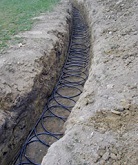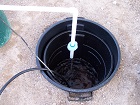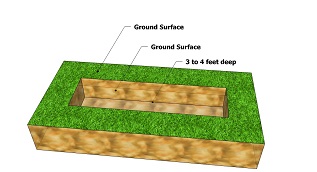
First
you will want to select a place to dig your trench and you'll want it
to be 3 to 4 feet deep. The length of the trench really depends on many
factors such as the type of tubing used, size of tubing (½ in, ¾ in
etc.), how thick the wall of the tubing is, how densely you pack the
coils into the trench and the type of soil. Even how big (gallons of
solution) the reservoir is, and the temperature of the solution to
begin with, are big factors. Though a trench from 10 to 15 feet long
should do nicely. (Note: The trench can be as wide as you want
and can even have multiple rows of coils in it)
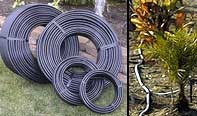
Polyethylene
tubing can be found in any local hardware store with the drip
irrigation supply's. Of coarse you want to use the solid tubing and not
the tubing with pre-drilled holes or the soaker tubing, those will leak
your nutrient solution into the ground. The smaller the tubing the
better the heat transfer will be.
I would probably use the ½
in tubing because that is the outlet size of most of my pumps. Although
you can also use a reducing “T” connecter, to go from the ½ inch tubing
to 2, ¼ inch lines. Then use another “T” connector at the return end to
bring it back up to the ½ inch tubing again. Also the more coils of
this tubing in the ground the more cooling effect you will be able to
achieve. There are just too many possibility's of connectors, adapters
and fittings for me to list, but just ask about these at your local
home improvement store in the drip irrigation and gardening
sections.
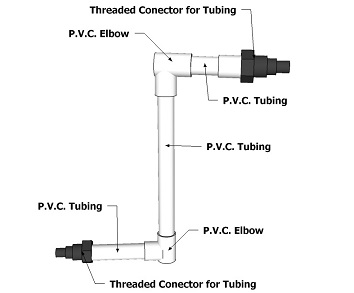
(Note:
Keep in mind the longer the tubing and the larger the diameter of the
tubing the more fluid the tubing will hold, and will add to the amount
of nutrient solution need to run the system without running your
pump dry)
You can connect the tubing inline with your
pump system a few ways, I like using P.V.C. myself so that is what I
have shown here. It's inexpensive and is easy to connect and
disconnects from the system. It's quite simple, basically you just cut
and glue together a few pieces of P.V.C. (after measuring of coarse).
The threaded connectors for the tubing can be found with the drip
irrigation supply's and the P.V.C. connectors that they thread into,
can be found with the P.V.C. connectors. This way you can quickly
disconnect the vinyl tubing from hydroponic system for any maintenance,
as well as if you decide to use it for a different hydroponic system.
(Note: you need 2 of these, one for each end of the geothermal
tubing/coils)
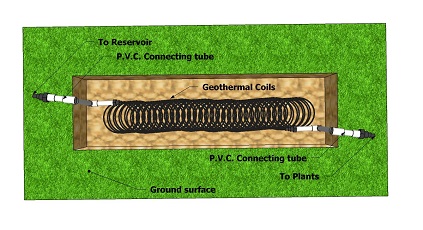
Now
that you have the trench dug and the P.V.C. connector tubes made
for both ends of the Geothermal coils, the rest is simple. Just lay the
tubing in the trench, and lay it down like a long flat row of coils.
Then connect the connecting P.V.C. tubes, and make sure they are tight
so they wont leak.
If there's a lot of rocks in the ground
soil you should consider laying down a 3 to 4 inch thick layer of sand
or sifted soil before laying down the coils. Also you would want
to put another 3 to 4 inch thick layer of this same sand or sifted soil
on top of the coils before refilling the trench. You can use the same
soil you dug out, just use a large screen to to sift the rocks out. Or
if you want to you can hand pick them out (but this might take a
while). This will prevent the tubing from being punctured from rocks in
the ground as the soil settles back down after you fill it back in.
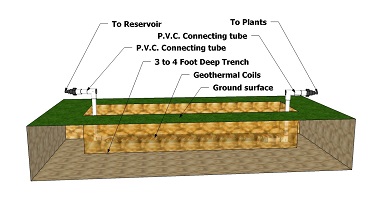
Now
that you have everything in place all you need to do is fill the dirt
back in the trench. Then connect lines from the nutrient reservoir and
plants to the fittings that are above ground.
You will want to
cover the above ground P.V.C. tubing and lines to both the reservoir
and plants with pipe insulation, this to keep them from heating up your
cooled nutrient solution. You can get pipe insulation at any home
improvement store with the pluming supply's. It usually comes in 6 or 8
foot lengths and in different diameters for different diameter pipe,
and runs a buck or two each. This will go a long way to keeping your
nutrients cool, especially if you need to run the lines for any length
of distance.
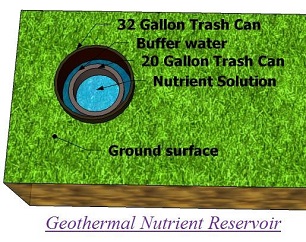
To
make your cooling system even more efficient you may want to utilize
the Geothermal Nutrient Reservoir that I designed in conjunction with
this trench system. By keeping the nutrient reservoir in the
ground you will get the same Geothermal cooling effect with the
reservoir as you do with the coils, and the nutrients wont need to be
cooled much by the coils. Making your cooling system much more
efficient and your plants happier.

